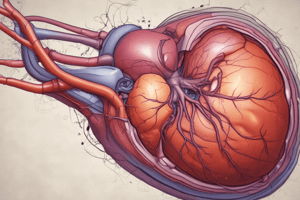Podcast
Questions and Answers
What is the most common cause of hepatic failure when 80-90% of hepatic function is gone?
What is the most common cause of hepatic failure when 80-90% of hepatic function is gone?
The most common causes of hepatic failure when 80-90% of hepatic function is gone are massive hepatic necrosis, fulminant viral hepatitis, and drugs/chemicals (e.g. phenacetin, halothane, anti-TB medications, antidepressants, Amanita phalloides mushrooms).
What are the clinical features of hepatic failure?
What are the clinical features of hepatic failure?
The clinical features of hepatic failure include jaundice, edema, spider angiomas, hypogonadism, gynecomastia, encephalopathy, coagulopathy, and hepatorenal syndrome.
How do stellate cells or Ito cells transform during cirrhosis?
How do stellate cells or Ito cells transform during cirrhosis?
During cirrhosis, stellate cells or Ito cells transform into myofibroblasts that make and deposit collagen types I and III throughout the liver lobule, replacing the normal type IV reticulin between sinusoidal endothelial cells and hepatocytes.
What are the alterations in hepatic blood flow that lead to portal hypertension in cirrhosis?
What are the alterations in hepatic blood flow that lead to portal hypertension in cirrhosis?
What are the major clinical consequences of portal hypertension in cirrhosis?
What are the major clinical consequences of portal hypertension in cirrhosis?
How does the disorganization of the hepatic circulation in cirrhosis impair the movement of proteins between hepatocytes and plasma?
How does the disorganization of the hepatic circulation in cirrhosis impair the movement of proteins between hepatocytes and plasma?
Flashcards are hidden until you start studying




